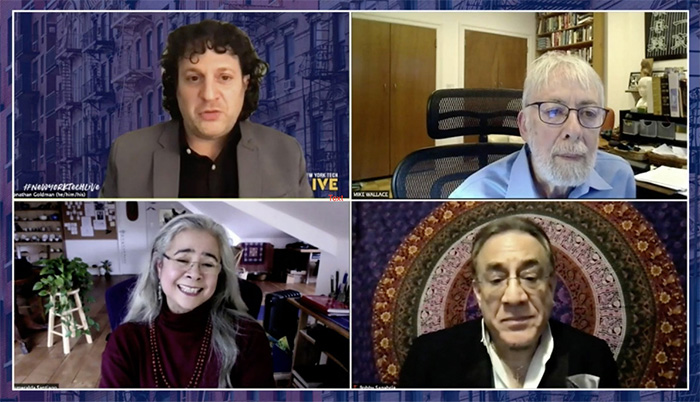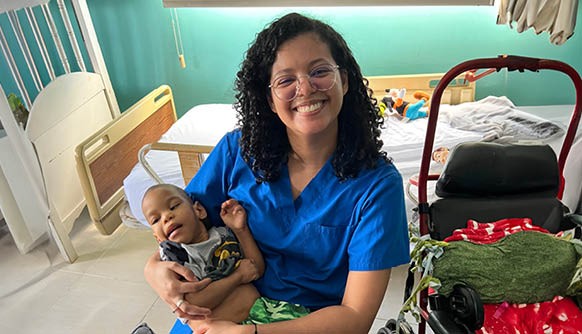News
New York Tech Live: When New York Was Puerto Rican
April 8, 2021
At the inaugural “New York Tech Live” on March 24, a panel of iconic New Yorkers discussed the monumental impact of West Side Story on their lives and work, set in the context of New York City and urban planning for the Upper West Side.
Panelists Mike Wallace, a Pulitzer Prize-winning historian; multiple Grammy-nominee Bobby Sanabria; and writer Esmeralda Santiago joined New York Tech Faculty Fellow and English professor Jonathan Goldman, Ph.D., at the virtual symposium “West Side Story: How It Speaks to Us Now.”
Also participating were Sean Khorsandi, executive director of Landmark West! and instructor in NYIT School of Architecture and Design, who interviewed Wallace, and New York Tech English major Quiana Dudley-Vegliante (B.A. ’21), who interviewed Santiago. The event was the product of the university’s first Faculty Fellowship, a program designed to support faculty projects in service to the community.
The Backstory
The Broadway version of West Side Story, with music by Leonard Bernstein, book by Arthur Laurents, lyrics by Stephen Sondheim, and direction and choreography by Jerome Robbins, premiered at New York’s Winter Garden Theatre in 1957; the Hollywood film was released in 1961.
Panelists addressed both stage and screen iterations of the story, a modern adaptation of William Shakespeare’s Romeo and Juliet set among Anglo and Puerto Rican gang members in 1950s Manhattan. Its setting: just a short walk from New York Institute of Technology’s New York City campus. Themes of racial tension and conflicts, equity and inclusion, urban renewal, Latinx culture, musicology, and more permeated the individual presentations and the panel discussion and Q&A that closed the 2.5-hour event.
As a musician and educator, Sanabria talked about the music and the original 1957 production as it was conceived by Robbins, Bernstein, Laurents, and Sondheim—including its setting on the West Side. His band (the Bobby Sanabria Multiverse Big Band) released “West Side Story Reimagined” in 2018; it was later nominated for “Best Latin Jazz Album” at the Grammys. A fresh approach to Leonard Bernstein’s original score, it emphasized Afro-Latin rhythms, which Sanabria explained in his presentation.

Pictured clockwise from top left: Jonathan Goldman, Mike Wallace, Bobby Sanabria, and Esmeralda Santiago
Santiago arrived in Brooklyn as a young teenager from Puerto Rico in 1961, just before West Side Story was released as a film. “Probably the first film I saw in the United States was West Side Story,” she told Dudley-Vegliante. Her memoirs, When I Was Puerto Rican (1993) and Almost a Woman (1999), tell about her experience of New York in the 1960s.
Wallace literally wrote the books about the history of New York City: Gotham (1999, co-authored with Edwin G. Burrows) and its sequel, Greater Gotham (2017). Since Khorsandi works in preserving the unique character of New York’s West Side, the two men discussed the setting of the film in the West Side neighborhood known in the 1950s as San Juan Hill. Contrary to what West Side Story presents, the neighborhood was “a polyglot populace,” where working class people of many ethnicities lived peacefully. Nevertheless, their homes were torn down in the late 1950s to make room for more upscale properties like Lincoln Center.
At the end of each discussion segment, the panelists shared a final thought on the movie’s lasting impact. Santiago emphasized her desire for Puerto Ricans and “Nuyoricans” to tell their own stories. Sanabria said the story of “two people that love each other” in a world driven by hate reflects “problems we are still tackling today.” Wallace suggested that modern equivalents of “Sharks” and “Jets” will continue to raise conflict and division.
Student Perspectives
In a virtual event the day before the main event, four undergraduate students in Goldman’s LatinX Literature class shared their projects related to the West Side Story theme.
Elizabeth Ortiz (B.S. ’21), Jaycee Greer (B.S. ’22), and John Jumpa (B.S. ’22) talked about the film’s locations in their project, “West Side Story: Filming Locations in the Year 2020.” Contrary to the film’s title, many scenes were actually shot in California and on the East Side of New York City, with only select scenes filmed on the West Side. However, scenes that were filmed on location, specifically on West 68th Street, between West End Avenue and Amsterdam Avenue, should be familiar to many New York Tech students. They are near Lincoln Center, not far from the New York City campus.
At the time the movie was filmed, Lincoln Center was undergoing renovations as part of an urban renewal project. This allowed filmmakers to tailor the landscape to fit West Side Story’s gritty atmosphere.
Karibay Angeles (B.A. ’22) shared a project she worked on with three classmates. “Esmeralda Santiago: Life and Work” details the hardships that the author overcame as a LatinX female coming of age in the 1960s. Angeles, who is originally from the Dominican Republic, talked about how Santiago’s work continues to inspire LatinX women like herself.
Watch the entire symposium, including the student presentations. As organizer Goldman put it, the discussion is “worth revisiting,” particularly as the world awaits the new Stephen Spielberg version of West Side Story due out later this year.
.jpg)





